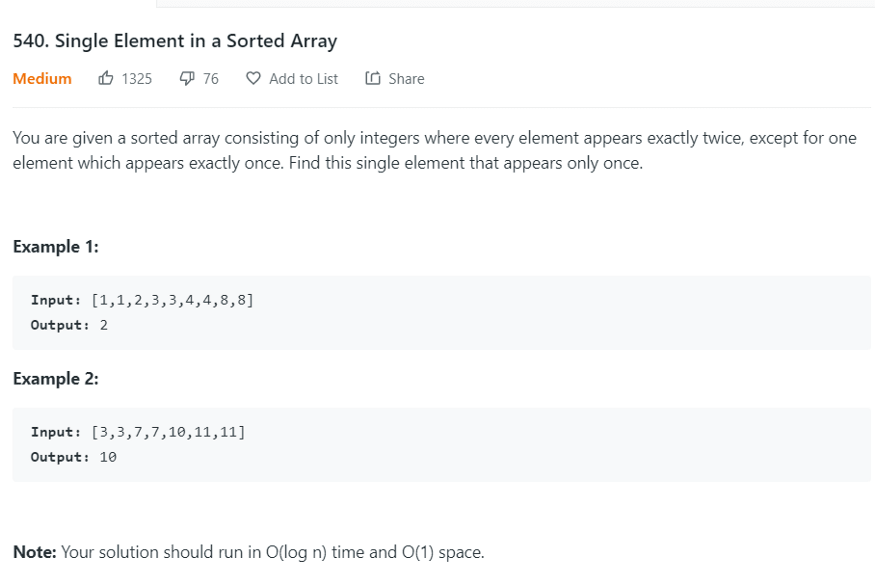This is a medium Leetcode 543 question. You are given an array of integers of which all elements in the array appear twice except one. The question is to get the one that does not have any duplicate (i.e appeared just once). See problem description below:
NOTE: The solution should be in O(log n) and O(1) space.
The above problems can be solved in so many ways but I will talk about three ways to solve it in decreasing order of performance.
FIRST ALGORITHM (THE UGLY)
The first solution that came to my mind was to use a HashMap. There is a saying that goes thus;
For every question you encounter, always think HashMaps, there is a probability that you will solve the problem with HasMap 😂😂😂.
The idea is to store the count of elements in the array inside a HashMap with the element as the key and the count as the value.
Then next step is to loop through return the key that its value is 1 because if the value is 1, definitely that’s the odd one. The code is shown below:
public int singleNonDuplicateUsingHashMap(int[] nums) {
HashMap<Integer, Integer> map = new HashMap<>();
//store the count of each element in the map
for (int i = 0; i < nums.length; i++) {
if (!map.containsKey(nums[i])) {
//if the key doesn't exist, create a new one
map.put(nums[i], 1);
}else {
//update the count of the existing by incrementing it by 1
map.put(nums[i], map.get(nums[i]) + 1);
}
}
//loop through map and get the one that has the value of 1
for (Map.Entry<Integer, Integer> entry : map.entrySet()) {
if (entry.getValue() == 1) {
return entry.getKey();
}
}
return -1;
}
The above code works just fine but the runtime is O(n) for each of the loops which translates to O(n) + O(n) which is equal to 2O(n). 2O(n) is the same as O(n) because we don’t consider constants in calculating runtime. To make this slightly better, let’s look at another algorithm.
SECOND ALGORITHM (THE BAD)
1.Loop through the array by incrementing the count by two (2);
2.check if the current element is equal to the next element;
3.if they are not, that means that current element is the odd one without a duplicate. See the steps in the image below;
STEPS
The first step starts from element at index 0(i=0), checks if the next element at index(i+1) is the same. Since they are the same, it increments the index (i) by 2. It follows the same process for Step 2.
For step 3 which is at index 4, it checks and finds out they are not the same, so it returns value at the current index (i=4)which is 10. The code is shown below:
public int singleNonDuplicateLinearly(int[] nums) {
if (nums.length == 1) return nums[0];
for (int i = 0; i < nums.length; i+=2) {
if (i == nums.length - 1) return nums[i];
if (i+1 < nums.length && nums[i] != nums[i+1]) {
return nums[i];
}
}
return -1;
}
THIRD ALGORITHM (THE GOOD😎😎😎)
If you look at the problem description, it says that the runtime should be O(log n) and space complexity of O(1).
Whenever you see a question that says runtime should be O(log n) and space complexity of O(1), just know that the solution would probably involve Binary Search.
- As with every binary search, it starts from the middle (divide the array into two halves);
- checks the right half elements to know if they are even number of elements left. if they are even (stores the state in a variable (isEven)), there is no way the odd number would be in the second half if they are even.
- From the element at middle, it checks the element before it to know if they are equal.
- If they are equal and the variable isEven is true, it moves the right arrow to be at two elements before the middle element (mid-2). if the variable isEven is false, it moves the left arrow to start from an element after the middle element (mid+1).
- If they are not equal, and isEven is true, it moves the left arrow to two elements after the middle element. If they are not equal, it right arrow to an element before the middle element.
public static int singleNonDuplicateUsingBinarySearch(int[] nums) {
int lowLeft = 0;
int highRight = nums.length-1;
boolean isEven;
while (highRight > lowLeft) {
int mid = lowLeft + (highRight - lowLeft) /2;
//check if the right side is even
isEven = (highRight - mid) % 2 == 0;
if (nums[mid] == nums[mid-1]) {
if (isEven) {
highRight = mid - 2;
}else {
lowLeft = mid + 1;
}
}else if (nums[mid] == nums[mid + 1]){
if (isEven) {
lowLeft = mid + 2;
}else {
highRight = mid - 1;
}
}else {
return nums[mid];
}
}
return nums[lowLeft];
}
Thank you for reading. Please drop a comment.









Top comments (3)
Nice!
Another way would be bit-wise manipulation.
Perform XOR operation for every element. The result of XOR operations will be our required result.
wow i would love to know how to do that. Not so good with bit manipulations. Please can you help. would love to learn from you thank you.
wow awesome. but this stills runs in O(n)....using Binary search will run in O(log n)